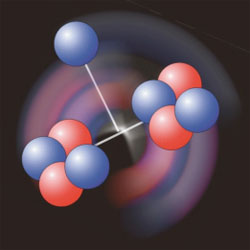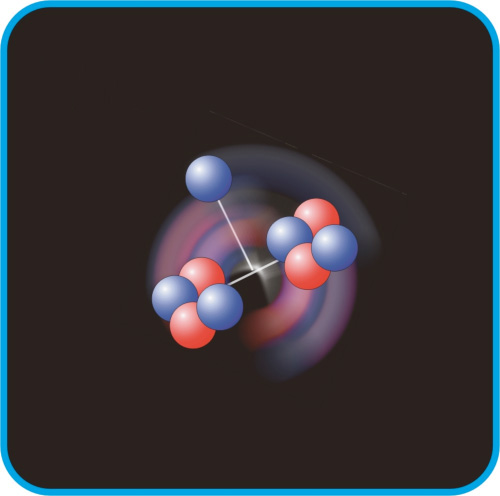Quarks Influenced by Their Neighborhood
The internal structure of a proton or neutron is not completely fixed–experiments going back decades suggest that the particles are slightly different when inside a nucleus. Now results in the 13 November Physical Review Letters show that the effect is not dependent on the mass or on the density of the entire nucleus, as some theories have predicted. Instead, neutrons and protons appear to change according to their immediate neighborhood within the nucleus.
Protons and neutrons (“nucleons”) are made up of three highly energetic quarks that move around in their tightly confined space with a broad range of different momenta. It was assumed that this momentum distribution would be unaffected by the nuclear environment, since the binding force between the quarks is hundreds of times greater than that between the relatively widely-spaced nucleons. But in 1983, the European Muon Collaboration (EMC) at CERN near Geneva discovered that the quarks in iron nuclei were about 20 percent less likely to be moving with high momentum than quarks inside free nucleons. “It’s as if you put an apple in a bucket and it started looking like a pear,” says Gerald A. Miller of the University of Washington in Seattle.
One possible explanation is that a nucleon inside a nucleus swells a bit, compared with a free nucleon, because its own quarks are attracted to neighboring quarks. In quantum mechanics, larger size is associated with longer wavelengths, lower energies, and lower momenta. Since 1983, others have measured the so-called EMC effect and shown that as one goes to larger, denser nuclei, the effect becomes more pronounced–that is, there are fewer high-momentum quarks per nucleon. Many theories have been proposed to account for the effect in detail, some claiming it increases with nuclear mass, others claiming it increases with nuclear density, but the data have not been precise enough to rule out any of these models.
Now John Arrington of Argonne National Laboratory in Illinois and his colleagues have data from Jefferson Lab (JLab) in Newport News, Virginia, that should have theorists scrambling. The team measured the EMC effect in small nuclei, where previous data have not been very good. They chose samples of helium-3, helium-4, beryllium-9 and carbon-12, since these nuclei offer a good range in both nuclear mass and nuclear density. The researchers placed their samples in a high-energy electron beam (5.8 GeV) and measured the electrons that scattered off the target. The data analysis showed that the EMC effect was weakest for helium-3 and about equal for the three other nuclei, despite their diversity in density and mass. These results, which surprised Arrington and his colleagues, rule out both mass and density dependence for the effect.
The team thinks the EMC effect depends instead on the local environment of a nucleon inside the nucleus. The most telling example is beryllium, where the nucleus is made up of two clusters that resemble the helium-4 nucleus, plus an extra neutron. Electrons colliding with one of these two dense clusters will encounter a quark distribution matching the one inside the helium-4 nucleus. “It’s a nucleon’s nearest neighbors that influence how its quarks move,” Arrington says. To test this hypothesis, the team plans to look at other nuclei that have dense clusters. They also will try to relate the EMC effect to close encounters of nucleon pairs that were recently identified at JLab [1].
“What the result means, I don’t know yet,” says Miller, who was not involved in the experiment. “Something new has to be done to explain the EMC effect.” He believes the authors’ explanation makes sense, but a fuller understanding will require the joint effort of particle physicists who study quark interactions and nuclear physicists who can model the internal structure of the nucleus in detail. Douglas Higinbotham of JLab says this “beautiful result” might help researchers understand other instances of dense nuclear matter, such as neutron stars.
–Michael Schirber
Michael Schirber is a Corresponding Editor for Physics Magazine based in Lyon, France.
References
- R. Subedi et al., “Probing Cold Dense Nuclear Matter,” Science 320, 1476 (2008)
More Information
JLab news release, including data plot
JLab news release describing reference [1], a Science paper about correlated nucleon pairs





